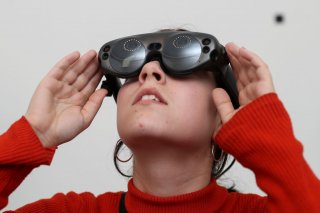How Augmented Reality Can Help Americans Understand Arms Control
A clever technology for a socially-distanced age.
It is clear that as coronavirus continues to take center stage in global affairs, more and more people, organizations, and corporations have begun exploring new ways to reach their audiences. These new mediums for communication go beyond Zoom calls and televised advertisements encouraging people to stay at home.
Corporations have been capitalizing on new realities to explore innovative mediums. Brands have had to create new ways to reach their target audience as the world collectively shut down to flatten the curve. For example, the incredibly successful skincare company Glossier, released a new hand cream product by creating an augmented reality model of what the product would look like, sent it to beauty and Instagram influencers, and encouraged them to share pictures of the product virtually placed amongst other products on their shelves. The timing was well thought out as well: a hydrating hand cream released around the same time skin was being dried out by meticulous bursts of washing and increased use of dehydrating hand sanitizer.
The global pandemic has forced corporate entities to critically reevaluate their modes of communication in order to reach audiences that no longer have such a close proximity to their products.
However, this shift to new mediums is not limited solely to corporations. As the world slowly opens up, creative ways to ensure that the virus is contained are also necessary. Elementary educators in China have resorted to putting “socially distancing” hats on students to ensure the young children remain six feet from one another. Similarly, law enforcement in India has resorted to dressing up as the virus in order to remind people to stay at home.
From this, it is evident that visualizing to promote understanding of the unseen is now more important than ever. It is also evident that the international security policy community has an opportunity to learn from this pivot to new mediums.
While the majority of international security policy organizations have shifted to online work, they have yet to embrace new mediums that could help them achieve their goals of reaching new audiences with their work. The majority of post-coronavirus work in the international security space has taken the form of Zoom calls, conference calls, and virtual happy hours; all of which tend to repeat or reiterate past lectures and lessons to the same audiences. The community has embraced the occasional e-learning module as well, so as to break up the Zoom monotony, but it is clear that these online approaches don’t exactly provide something new—the same approaches have just been digitized.
Corporate precedents have begun to pave way for the international security policy community to embrace new mediums in a post-coronavirus operating environment. While an AR hand cream is likely not the ideal medium for this community, this example demonstrates what creative and fresh mediums have the ability to look like.
There are few limitations regarding the shape these new mediums might take. For example, my employer, The James Martin Center for Nonproliferation Studies (CNS), has begun exploring new tools for communicating issues related to weapons of mass destruction. CNS has employed tactics such as creating 3D models, playing with Augmented Reality, and drafting coloring books in order to find new ways to talk about nuclear weapons.
Similar organizations should consider capitalizing on emerging mediums to provide new lessons to new audiences. For example, organizations that use geospatial data to describe and understand international crises could consider platforms like Cesium, a company that provides a platform to use 3D data in order to better visualize and analyze their subject matter in a way that is easy to use. The power of storytelling has also gained traction in light of recent events. Media platforms like Inkstick Media seek to de-jargon national and international security issues through stories told by, and for, the everyday person. Data also has untapped storytelling potential. Digital platforms, such as Cerosetenta, a platform sponsored by the Center for Journalism Studies of the University of the Andes, seek to explain the national reality of “news” through investigation and narration. A recent story about an uprising at the prison “La Modelo” in Bogota, demonstrates how this platform uses multiple streams of data to provide the story of what really happened, going beyond catchy headlines. Lastly, data visualization has become incredibly important. There has been an onslaught of graphs and figures with the rise of coronavirus, and they have proved to be incredibly useful. Organizations like the Data Visualization Society and The New York Times’ Visual Investigations have begun to demonstrate the importance of accurately and effectively visualizing data in the international security policy sphere.
But this is just a start. More organizations in the international security policy community need to embrace the concept of new mediums in order to survive and thrive in the wake of 2020’s global pandemic. As corporations have shown, proximity to an issue is no longer a prerequisite for audience engagement… if you use the right medium.
Jamie Withorne is a Research Assistant at the James Martin Center for Nonproliferation Studies, an affiliate of the Middlebury Institute for International Studies. She regularly conducts data analysis on the nexus of emerging and nuclear technologies, as well as North Korean sanctions evasion activities and fuel cycle capabilities.
Image: Reuters

